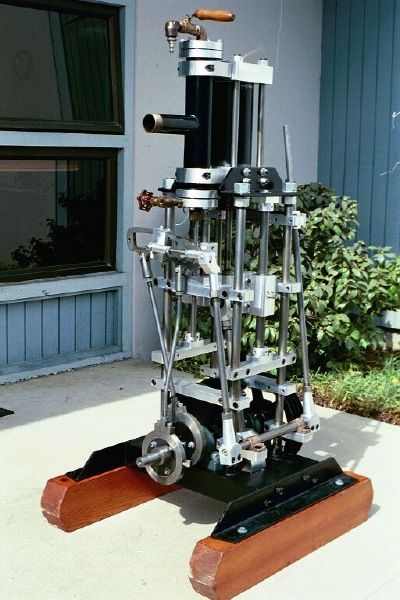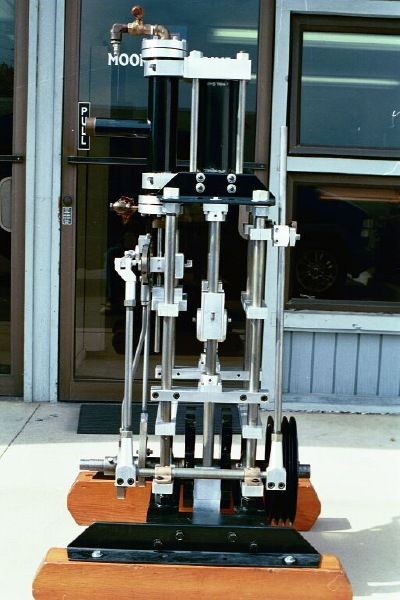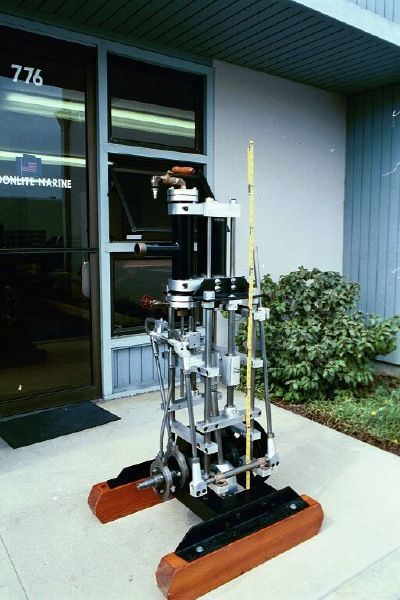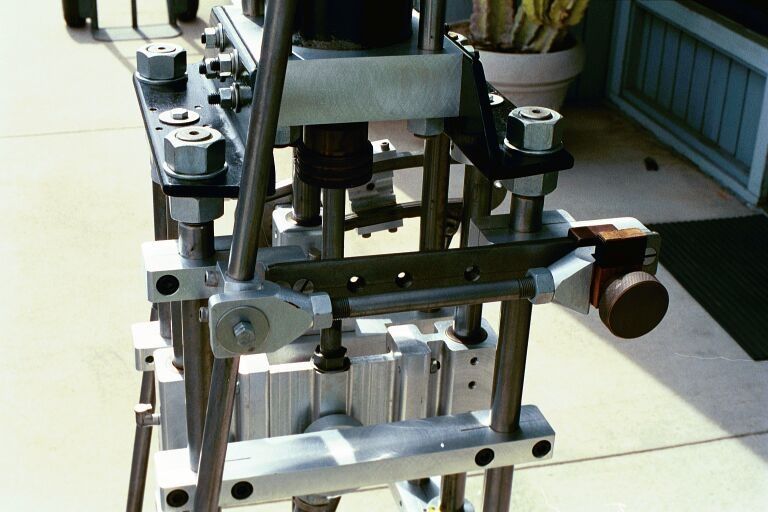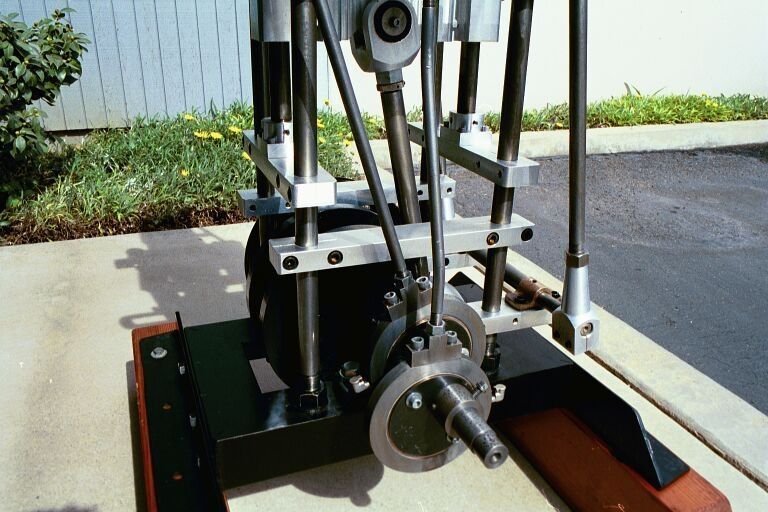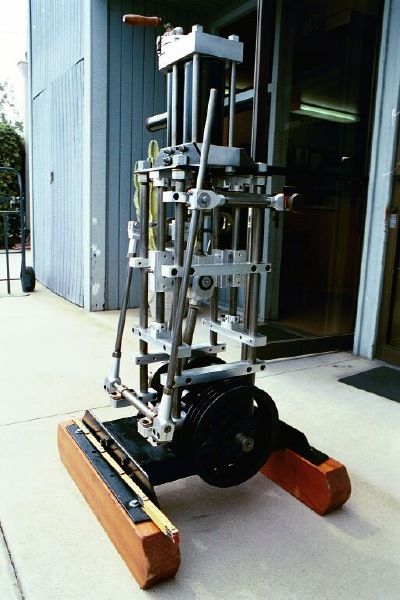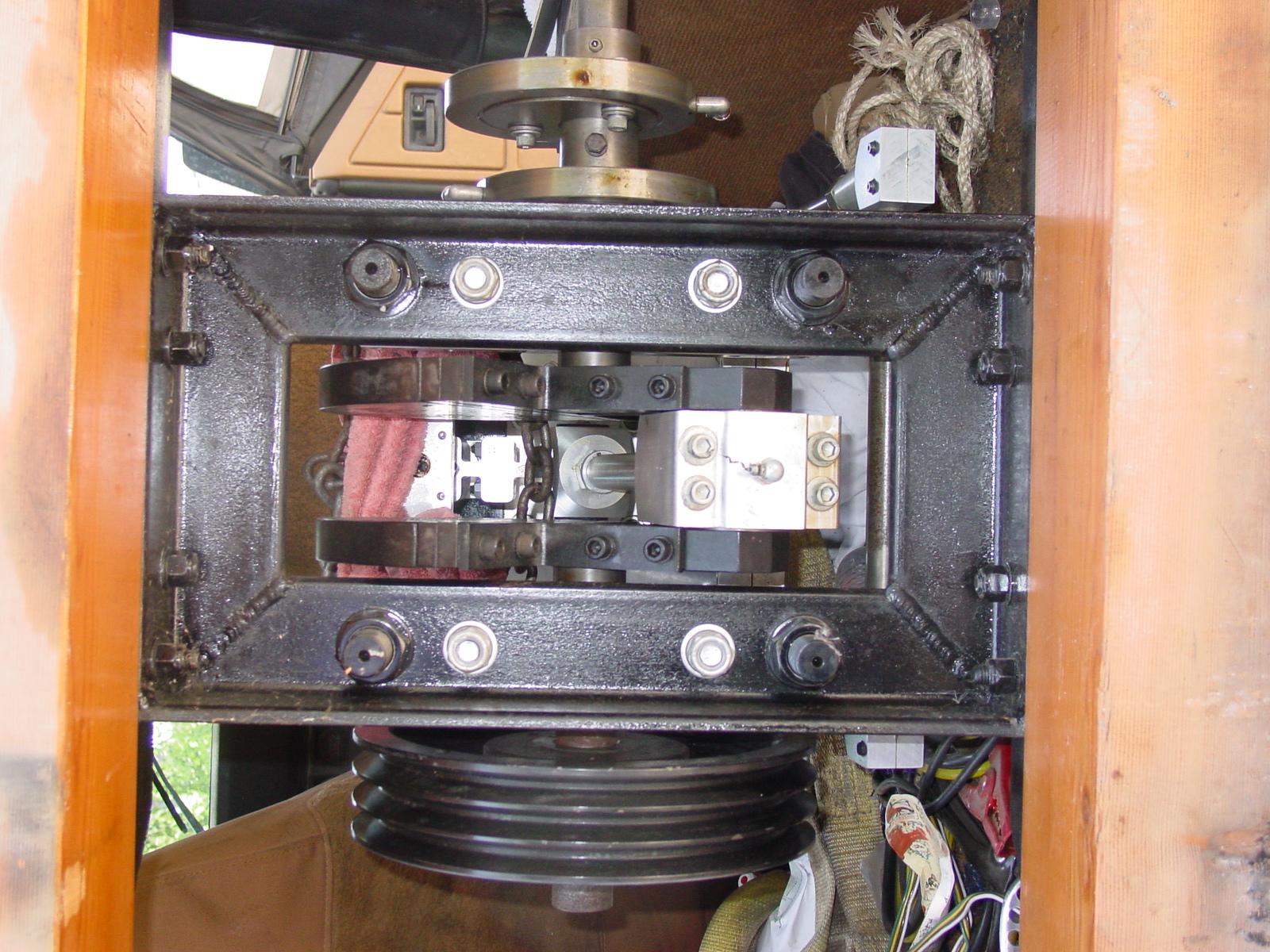Hurlothrumbo Today and Tomorrow
The Oyster Club is building a modern hurlothrumbo. To be more accurate we are pouring ourselves cocktails, sitting around campfires and talking about building a hurlothrumbo. I hope you have read the Hurlothrumbo History Lesson or this won't make much sense. (The Clamper's motto is credo quia absurdum. We like it when things don't make sense.) For physical evidence to guide us, we have some leaf springs and pieces of redwood rusting away outside of Murpheys California. We believe these to be authentic. We know the location of a boiler built in 1833, but there is no evidence that this was the hurlothrumbo boiler despite claims to the contrary. The Dibble family has handed down the brass plaque from the Norton Hurlothrumbo works that was on the original hurlothrumbo. This has been promised to us should we restore the hurlothrumbo. The current head of the Dibble clan demands that Platrix make him a humbug like his great great grandfather. The greybeards have indicated they are always open to bribery, but so far the answer remains "No thank you." Dibble has indicated he will take his plaque to "any chapter of ECV that makes him a better offer."
What we know for certain about the historical hurlothrumbo
We know from Norton's papers in the Bancroft Library that Norton sold his humidor and bar fixtures from the ship Hurlothrumbo to Dibble to be used in construction of what Dibble called a "hurlothrumbo", and the meeting between Dibble, Potter and Norton is documented in Norton's own hand with Dibble's calling card preserved in the diary. We have read (but are not allowed to copy or present here) Twain's manuscript which was rejected by Henry Clapp of the New York Saturday Press, but we don't know how much of this can be believed. Twain's account describes Dibble's hurlothrumbo surrounded by four hundred drunken, cigar-smoking clampers who are butt naked while their filthy clothes are being washed by 25 Chinese-Americans (Not Twain's exact words). He describes a Hangtown fry of 3000 oysters and 1000 eggs prepared in a steam jacketed kettle connected to the hurlothrumbo boiler. Beyond that we can't get more specific regarding details of the original hurlothrumbo. Sadly the engineering drawings for the hurlothrumbo were destroyed in the explosion and fire that killed Potter while he was experimenting with his ether based refrigeration system. The fire was documented in newspapers of the day. We would be delighted to provide historians with a bibliography.
Basically the hurlothrumbo was a traveling bar, humidor, kitchen, bath and laundry that provided entertainment and stress relief to hardworking, but free spending 49'ers. We are planning to build a similar device based on a 24' automobile carrier trailer that can be a similar focus of entertainment for modern clampers. The hurlothrumbo will use 19th century technology except where this conflicts with modern safety and environmental requirements. Today it is impractical to pump water from a stream and use firewood for heating. This made sense in the 1850s, but it would be irresponsible today.
Many clampers think this sacrilege. They believe any hurlothrumbo should be "historically accurate". Get a life guys! Cast iron boilers blew up and killed people frequently in the 19th century. Recently there was an explosion of a traction engine at a county fair in the Midwest that killed or injured a dozen people. We plan to use a modern, licensed, automatic boiler. Modern steam boilers run unattended safely in factories, laundries and in the commercial food preparation industry, and there hasn't been an explosion in decades.
We see the hurlothrumbo as the center for clampers to gather around. It will have a kitchen, bar, lighting, music, refrigeration and humidors. Appliances will be steam powered
We have named our hurlothrumbo "The Big Easy" in homage to the city of New Orleans; home of great food, cocktails, music and a clamper-style way of life. It is also named after Easy Sloman XNGH of Platrix who has passed on to the Golden Hills.
We will be using a commercial boiler licensed for unattended operation. We plan to put some sheet metal around it and build a smoke stack so it will look like an old-fashioned boiler, but we will make no compromises on safety or environmental friendliness.
We have a steam engine which we have named "Little Ernie". Little Ernie is an inefficient single-cylinder 4" bore by 8" stroke. We expect it to consume about 15 horsepower worth of steam running 150 psi at 200 RPM.
Here is the Little Ernie Picture Gallery: Click on the pictures to make them bigger.
I am pleased to note that Little Ernie has already managed to offend a number of "steam and railroad buff clampers". They find the notion of building a steam engine from modern alloys and components to be somehow offensive. I have had to turn down several offers of rusted hulks that some old duffer is "going to get around to restoring" some day.
On the other hand much criticism is correct. Little Ernie was designed as a marine engine, and the reversing mechanism is unnecessary for stationary operation. (But it is a lot of fun to watch.) We also need an oil pump that can inject oil into the cylinder.
Requirements Documents for The Big Easy
Listen up This is serious stuff:
May 8, 6006 AD
To: My Platrix Comrades
From: Chief Engineer, somewhere over Mid-Continent
Re: Getting In Touch With Our Roots
Dear friends,
I've left Swatman and crew sweltering in Texas and am now enroute to the Silicon Valley. I've had an excellent lunch and am finishing the last of only three (!) mini-bottles of The Glenlivet onboard (I made them bring up the one they had in Steerage), and now I wish to expand on my e-mail message of this early morning.
Clamper Tusler has hit the proverbial nail on the head. We need to bring some of the history back into this California History and Drinking Society (not necessarily in that order), and the Oyster Club can be the catalyst.
Clamper Tusler has expressed some well-merited concern about the interface between 19th-century technology and the needs of the 21st, particularly in providing suitably-filtered and regulated power to operate videocassette recorders and CD players. I am presently working as Technical Consultant on a life-of-Nicola-Tesla feature film, to be produced in Kiev (with working models of most of Tesla's apparatus), and I can easily build a contemporary vibratory, polyphase voltage regulator to convert the dynamo-generated direct-current to 60-Hertz AC. Beyond that, we can still procure line shafting, belting and ratcheting-lever clutch mechanisms from a variety of industrial suppliers.
We all remember THE BAR, now sequestered in some dank garage in De La Guerra Y Pachuco territory. As Clamper Pete so aptly put it, the Platrix hurlothrumbo should see and raise the stakes vis-à-vis that wonderful traveling monument.
Think of it! Early arrivals, pitching tents and unrolling their bedrolls, would hear the shrill shriek of the steam whistle and the clang of the bell in the distance and would catch the acrid, sulfurous scent of coal smoke wafting in from the highway. Soon, the hurlothrumbo would appear, towed, lurchingly, into view, the castellated boiler stack belching fumes, brightwork gleaming, the engine a blur of polished forgings, flyball governor drumming in revolution, line-shafting turning, belts slapping, with a hapless PBC in the catbird seat, gripping the deadman lever to the safety valve with white knuckles as the boiler throbs beneath him.
Finally! The great machine arrives! Steadying stanchions are forced hydraulically into the ground. Imagine! The powered apparatus- the blenders, the bellows, the slicers and graters, the peanut roaster, the coffee grinder, the rotisserie, the carbon-arc searchlight all set into operation! The ice-making apparatus spitting out glistening blocks! The spigot on the beer cooler a-drizzle with frosty condensation! A sight not seen since the Mighty Corliss Engine was set to the task of powering all of the motive displays in Machinery Hall during the 1876 Philadelphia Centennial Exposition!
The boiler is re-stoked by the black-ganged PBCs. Brasso and sponges are handed out to those gobs suborned into housekeeping tasks. The steam-jacketed kettle, asbestos lagging shedding a cloud of lethal fibres, is opened, to reveal a savory Mulligan Stew, a redolent gumbo, piquant Oyster Club chili. Soda biscuits rise in the oven. A sweaty, muscular cook bastes the baron of beef turning on the spit. Vegetables? Vegetables?!? No! Meat! Meat will be our victual! And we will eat. We will eat and drink without stint. We will eat until our faces shine "with grease and gladness"*.
Ah! The on-board humidor [maintained at proper dewpoint temperature as displayed by the spirit thermometer (with its wick kept dampened by a pipette-wielding PBC) protruding from the cedar casework] is opened and its contents perused. The caged flame emits a blue glow as cigar tips are severed by the built-in cutter and dusky beauties are puffed into incandescence. Hinged cabinets swing out on their braces and the clamp Sutler is in business. Casks of rare essences are broached and poured out. Camp chairs are arranged and the on-board projection screen pulled down. A cord payed out and the kinescopic apparatus set into motion, the amplifying horns positioned for the proper stereophonic effect. The credits roll- "Bulk Male", with Mr. B in the title role. Gentlemen, as our esteemed and rotund colleague is often wont to say, "How not?"
This goal must be realized! I hereby nominate The Distinguished Graybeard, Pete the Spy, XNGH, Chairman of this, Most Important Committee, to bring the hurlothrumbo into being. What? Election by acclamation? Satisfactory!
And so recorded,
Chief Engineer (having switched to cognac with my coffee)
*from The Far Western Frontier, by Ray Allen Billington, Chapter 5,"The Era of the Mountain Men".
On the subject of refrigeration:
Ice cubes? Please, gentlemen, please. The state-of-the-art in 1880 was to circulate a low-temperature brine solution around metal water cans to freeze long rectangular blocks. The blocks were cut into large cubes only after they were loaded into the icewagons for door-to-door delivery. The Hurlothrumbo will make ICE, damnit! Ice tongs and ice picks will be provided, along with burlap sacking, so that PBCs might make deliveries to the different camp-bars. The Chief Cook is correct. There is no comparison between an effete ice "cube" and a nice chunk of properly-chipped block ice. Our only concession to modernity will be to supplant the original calcium chloride brine with an environmentally-friendly polyethylene glycol solution for proper heat transfer and operate the ice-making chamber at a suitable -15 degrees F.
Chief Engineer
On the subject of Oysters:
I would only suggest the variation of an Oyster Tank, circulating salt-water and filtering out much of the accompanying mud prior to the opening ceremony. Of course, a cutting board with machined depressions to coddle the oysters. A sauce station, with racked jars of chili sauce, Tabasco and a built-in horseradish grater and lemon squeezer. Kevlar gloves fastened to the station with stainless leashes (to prevent their unexplained migration).
Let us consider further the food preparation component. I am drawing up a fairly large, 4' by 6' dual-fuel (mesquite charcoal/propane) open grille with the capacity to prepare 70-80 steaks at a time. An adjacent stainless griddle, 3' by 4' for the morning's bacon and Hangtown Fry. Two ovens, one with a broiler, to warm breads and prepare biscuits. The steam-jacketed kettle, of course, for its versatile range of uses.
Chief Engineer
On the subject of coffee:
Gentlemen,
Of course, I expected that all parties would take it is a given that the hurlothrumbo would include apparatus to grind the Arbuckles and percolate them into a rich, aromatic brew. I am heartily tired of the dishwater served as "coffee" by our typical "caterers".
Chief Engineer
On the subject of Oyster Stew:
May I call your attention to the following item:
http://www.legionindustries.com/products/specskettle/directsteam/OC999.pdf
This is the sort of device as is used at the Oyster Bar at Grand Central Station to produce oyster stew. I suggest an expedition to steal the recipe and do general field work.
How do we get the steam down to 45 PSI and regulated? The engine requires much higher pressures if we are to have enough power to make ice and electricity.
Have you considered a direct absorption system for the refrigeration?
Of course Legion also carries larger pots suitable for Chili, but the oyster cooker is an essential on any hurlothrumbo.
I might mention that a steam jacked pot is essential to cooking Chili in the style advocated by the late Frank X Tolbert. His approach is to have 3/4 inch cubes of meat that have been infused with chili. Ideally the meat does not fall apart until your fork touches it in the bowl. This means long cooking without stirring the pot. Steam jacketed pots are the only way to get an even gentle heat so that there will be no burning on "hot spots".
Our style has been "chunks of meat in a meat sauce". The pieces of beef cheek, heart and tripe are not going to fall apart regardless of how much the pot is cooked or stirred. The chuck or round we use falls apart and makes a sauce.
I'd like to try making a Tolbert style chili, but this means keeping the drunks from opening the lid and stirring. Please note that Legion provides "prison options" on their industrial sized steam jacketed cooking pots. This option includes lockable lids.
Food for thought...
Chief Cook
On the subject of peanuts:
To: the brethren
Today I had lunch at Joe Jost's.
www.joejosts.com They have been serving fresh roasted peanuts since 1907, and installed a replica of a 1907 style peanut roaster. It is run by line shafting and leather belts. Clamper Fitz has offered to lead us on a tour of this establishment as it is one of his regular watering holes.Here is a link to a company that sells a peanut roasting machine http://peanutroaster.com/. This could be run off line shafting similar to the roaster at Joe Jost's.
Chief Cook
Exchange on the subject of water system for the bar:
To: Chief Engineer
Since the Hurlothrumbo will be named the Big Easy, it is incumbent that we serve proper New Orleans Cocktails. We will need absinthe glasses, but more importantly we need a fountain on the Hurlothrumbo to drip the water appropriately. Do you have any ideas for a proper water dripper? Should the water be "charged"?
Modern recipes call for soda water, but the original fountain at the Old Absinthe House probably didn't dispense soda water... or did it?
Arthur describes the fountain used for dripped absinthe as follows: "We find the marble bases pitted from the water which fell, drop by drop, from the faucets over the many years they served their mission." Charged water would be more likely to pit the marble.
Mixologist
To: Mixologist
My guess is that the water was not charged with CO2 in those days. This does not mean that The Big Easy should not have a connection to the planned carbonation system with a needle valve to drip as required. My plan so far is to have a CO2 tank with plumbing to the cooking area for emergency fire suppression and also to a chamber in the ice-making plant. There will be a carbonator pump to pressurize de-mineralized water to absorb the gas. This will have serious fizz. I will probably come out on the Wed. before the Trek. We can spend some time in technical discussion. I will bring blueprints to date.
Chief Engineer
The latest report from the Chief Engineer can be found here:
This page and the Big Easy are a work in progress. It will be updated as things progress.
